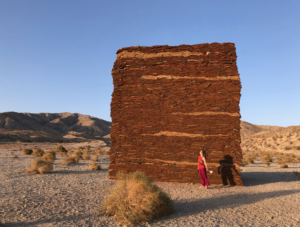With the pandemic easing in most of the US, brands are increasing their marketing budgets. It’s no wonder that some of that spending is focused on providing people with experiences (vs. advertisements). After all, we customers have been hunkered inside for more than a year. We’re approaching outdoor events as Rip Van Winkle reacted after being asleep for a long spell — eyes and hearts wide open to anything.

The North Face X Gucci Pit Stop at Desert X
As with all marketing efforts, there are ways to do experiences right and ways to do them wrong. For the latter, we need to look no further than the North Face X Gucci “Pit Stop” that was part of the 2021 Desert X event based in Palm Springs, California. Desert X presents art installations across 40 miles of the breathtaking Coachella Valley.
This year, the event sought “to explore the idea of the desert as a place where the marginalized and migratory — whose voices and histories may have struggled to manifest within the dominant discourses of growth and development — can also be heard,” states curator, Neville Wakefield. The North Face X Gucci Pit Stop, pictured here, was located amid 13 much more engaging art installations. To me, it perfectly illustrates five mistakes that companies should avoid when creating brand experiences.
One, it had little relationship to the promise of the desert experience itself. Yes, the Pit Stop served as a place to see maps of the installation locations, but there was no other tie-in to Desert X’s mood, purpose, or surprises other than the X in the pit stop’s title. The dome was not artistic in an inspirational or aspirational sense—and to the extent that it was, it offered no feeling of the desert. The pit stop might as well have been on 42nd Street in Broadway or at the base of State Street in Madison, WI. The structure and experience reminded me of store-brands that are all function, with no emotion. Bland. An oasis structure would make more sense given the desert setting.
Second, it did not deliver a memorable experience. The whole idea behind experiential marketing is to create a happening, be it fun, meaningful, emotional, or some other type of encounter. Lyft delivered cars driven by Zombies on Halloween Night a few years back. You could also invite a Lyft Zombie to your party. At a past New Orleans Jazz Festival, you could order a Lyft convertible with a jazz band playing in the back seat. These are memorable experiences worthy of posting on Instagram or Facebook. The Pit Stop, not.
Third, it prioritized advertising before experience. The hub looked more like a 3-D billboard rather than an invitation to experience something fun or meaningful. When my daughter and I visited, the pit stop was closed, and its QRT code link led us to a store for desert-inspired Gucci products, nothing to do with the Desert X experience. Even worse, the structure was located kitty-corner to the Palm Springs Art Museum and some of its outdoor sculpture. The location and construction reinforced the dome appearing as one large advertisement to museum visitors.
Fourth, the experience was not faithful to the promises of the two brands. The pairing of North Face and Gucci was promising. The brands are so opposite that their combination encouraged my fashionista daughter, who loves hiking, to seek out the location of the co-branded pop-up. She had hoped to find outdoor roughness blended with design elegance. Yet, there was nothing outdoorsy or elegant in the installation.
Finally, the effort fell short of what the competition is doing in experiential marketing, a tactic that is fast becoming a standard tool for building awareness and brand loyalty. AllTrails, a site that hikers use to find good trails in a new city, posted the short walk around the dome. (Was this posting part of the brand’s social media effort?) Two user comments summed up the experience. “This was not a hike. This is an ad campaign.” And, “This thing is dumb. Not a trail or a hike and should not have been posted on All Trails.”

What’s Behind the Wall?
The failure of North Face X Gucci is made even more apparent compared to art installations surrounding it. My favorite piece, shown to the right, was beautiful from afar and up close. Its evocation of Arabian architecture colors invited my daughter and me to contemplate its title—“What’s behind the wall?”—physically, emotionally, and intellectually. Though not part of any marketing effort, this installation and others like it set the bar high for visitors. And you’d think that North Face and Gucci, two brands with the money to do things right, could have risen to the challenge.
How sad that they did not.
